When organic matter is burned, such as in a wildfire, a power plant, a car’s exhaust, or in daily cooking, polycyclic aromatic hydrocarbons (PAHs) are released, a class of pollutants known to cause lung cancer. There are over 100 known types of PAH compounds that are emitted into the atmosphere on a daily basis. Historically, regulators have relied on measurements of a single compound, benzo(a)pyrene, to assess a community’s risk of developing cancer from PAH exposure. MIT researchers have discovered that benzo(a)pyrene may be a poor predictor of this type of cancer risk.
The team reports in a modeling study published today in the journal GeoHealth that benzo(a)pyrene plays a minor role (about 11 percent) in the global risk of developing PAH-associated cancer. Instead, other PAH compounds account for 89 percent of the cancer risk, many of which are not directly regulated.
Surprisingly, “degradation products” – chemicals formed when emitted PAHs react in the atmosphere – accounting for approximately 17% of PAH-associated cancer risk. Many of these degradation products are potentially more toxic than the emitted PAH from which they were formed.
Scientists have found that benzo(a)pyrene, traditionally measured to gauge the risk of developing cancer from exposure to polycyclic aromatic hydrocarbons (PAHs), is a poor proxy for this type of cancer risk.
The researchers hope that the findings will encourage scientists and regulators to look beyond benzo(a)pyrene and consider a broader class of PAHs when assessing cancer risk in a community. “The majority of PAH regulatory science and standards are based on benzo(a)pyrene levels. However, this is a significant blind spot that could lead you down the wrong path when determining whether cancer risk is improving or not and whether it is relatively worse in one location than another “Noelle Selin, a professor in MIT’s Institute for Data, Systems, and Society and the Department of Earth, Atmospheric, and Planetary Sciences is the study’s lead author.
Jesse Kroll, Amy Hrdina, Ishwar Kohale, Forest White, Bevin Engelward, and Jamie Kelly are among Selin’s MIT co-authors (who is now at University College London). Co-authors include Peter Ivatt and Mathew Evans from the University of York.
Chemical pixels
Benzo(a)pyrene has long been considered the poster chemical for PAH exposure. The indicator status of the compound is largely based on preliminary toxicology studies. However, new research suggests that the chemical may not be the PAH representative on which regulators have long relied.
“There has been some evidence suggesting that benzo(a)pyrene may not be very important, but this was from only a few field studies,” says Kelly, the study’s lead author and a former postdoc in Selin’s group. Instead, Kelly and his colleagues used a systematic approach to assess benzo(a)pyrene’s suitability as a PAH indicator. The team started with GEOS-Chem, a global, three-dimensional chemical transport model that divides the world into individual grid boxes and simulates the reactions and concentrations of chemicals in the atmosphere within each box.
They expanded on this model by including chemical descriptions of how various PAH compounds, such as benzo(a)pyrene, would react in the atmosphere. The researchers then entered recent data from emissions inventories and meteorological observations into the model and ran it forward to simulate the concentrations of various PAH chemicals around the world over time.

Risky reactions
The researchers began with 16 relatively well-studied PAH chemicals, including benzo(a)pyrene, and traced the concentrations of these chemicals, as well as the concentrations of their degradation products, over two generations, or chemical transformations. The team evaluated 48 PAH species in total.
They then compared these concentrations to actual concentrations of the same chemicals recorded by monitoring stations worldwide. This comparison was close enough to demonstrate that the concentration predictions made by the model were accurate.
The researchers then related the concentration of each PAH chemical to its associated cancer risk within each model’s grid box; to do so, they had to develop a new method based on previous studies in the literature to avoid double-counting risk from the different chemicals. Finally, they used population density maps to forecast the global number of cancer cases based on the concentration and toxicity of a specific PAH chemical in each location.
The cancer risk associated with that chemical was calculated by dividing the cancer cases by the population. The team calculated the cancer risk for each of the 48 compounds in this manner, then calculated each chemical’s individual contribution to the total risk.
This study found that benzo(a)pyrene had a surprisingly small contribution, of about 11%, to the overall risk of developing cancer from PAH exposure around the world. Other chemicals were responsible for 89% of the cancer risk. And degradation products accounted for 17% of this risk.
“We see lower concentrations of benzo(a)pyrene, but the risk is higher because of these degradation products,” Selin says. “These products can be orders of magnitude more toxic, so just because they’re at such low concentrations doesn’t mean they’re harmless.”
When the researchers compared calculated PAH-associated cancer risks around the world, they discovered significant differences depending on whether the risk calculation was based solely on benzo(a)pyrene concentrations or on a region’s broader PAH compound mix.
“Using the old method, the lifetime cancer risk in Hong Kong is 3.5 times higher than in southern India, but when you account for differences in PAH mixtures, you get a difference of 12 times,” Kelly says. “As a result, there is a significant difference in the relative cancer risk between the two locations. And we believe it is critical to broadening the group of compounds under consideration by regulators beyond a single chemical.”
This study was carried out at MIT’s Superfund Research Center with funding from the National Institute of Environmental Health Sciences Superfund Basic Research Program and the National Institutes of Health.















